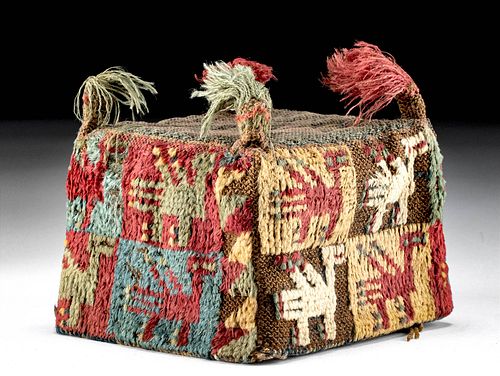Vibrant Huari Polychrome Textile Four Corner Hat
Lot 188
About Seller
Artemis Fine Arts
686 S Taylor Ave, Ste 106
Louisville, CO 80027
United States
Selling antiquities, ancient and ethnographic art online since 1993, Artemis Gallery specializes in Classical Antiquities (Egyptian, Greek, Roman, Near Eastern), Asian, Pre-Columbian, African / Tribal / Oceanographic art. Our extensive inventory includes pottery, stone, metal, wood, glass and textil...Read more
Categories
Estimate:
$7,500 - $11,250
Absentee vs Live bid
Two ways to bid:
- Leave a max absentee bid and the platform will bid on your behalf up to your maximum bid during the live auction.
- Bid live during the auction and your bids will be submitted real-time to the auctioneer.
Bid Increments
| Price | Bid Increment |
|---|---|
| $0 | $25 |
| $300 | $50 |
| $1,000 | $100 |
| $2,000 | $250 |
| $5,000 | $500 |
| $10,000 | $1,000 |
| $20,000 | $2,500 |
| $50,000 | $5,000 |
| $100,000 | $10,000 |
| $200,000 | $20,000 |
About Auction
By Artemis Fine Arts
Jun 10, 2021
Set Reminder
2021-06-10 10:00:00
2021-06-10 10:00:00
America/New_York
Bidsquare
Bidsquare : Exceptional Antiquities | Asian | Ethnographic
https://www.bidsquare.com/auctions/artemis-gallery/exceptional-antiquities-asian-ethnographic-7012
Museum-worthy examples of Egyptian, Greek, Roman, Viking, Near Eastern, Far East / Asian, Pre-Columbian, African / Tribal, Oceanic, Native American, Spanish Colonial, Russian, Fossils, Ancient Jewelry, Fine Art, so much more! Artemis Fine Arts info@artemisgallery.com
Museum-worthy examples of Egyptian, Greek, Roman, Viking, Near Eastern, Far East / Asian, Pre-Columbian, African / Tribal, Oceanic, Native American, Spanish Colonial, Russian, Fossils, Ancient Jewelry, Fine Art, so much more! Artemis Fine Arts info@artemisgallery.com
- Lot Description
Pre-Columbian, Central Coast Peru, Huari (Wari), ca. 700 to 1000 CE. A beautiful four cornered hat from the Huari culture made of low pile camelid (llama or alpaca) fiber that is brightly dyed. This hat has a characteristically square top that is adorned with green and red tassels. The sides of the hat present wonderful checkboard patterns of four stylized avian creatures standing in profile, all rendered in hues of red, beige, green, blue, purple, yellow, and brown. The pile is constructed from individual tufts secured to a woven base fabric. Huari ceramics containing figures are often depicted wearing these square hats, perhaps as indicators of rank. The natural dyes and motifs are beautifully preserved and demonstrate the remarkable skill of these Pre-Columbian weavers. Size: 4.8" L x 4.8" W x 4.125" H (12.2 cm x 12.2 cm x 10.5 cm)
Textiles and items containing woven textile materials were some of the most valuable items in Huari culture as they probably exacted them as tribute from the peoples they conquered. This makes it difficult for archaeologists to identify where these beautiful objects were originally woven, because they travelled so much around the Huari Empire. Huari textiles like this example, were likely formed by hand after weaving the colorful threads on a rectangular loom. The textiles that are preserved today are often from the desert areas between the Pacific Coast and the Andes; the Huari capital, in the highlands, was too wet to preserve cloth through the centuries, and as a result, textiles and hats like this are exceedingly rare.
According to the curatorial team at the Met, "Finely woven tunics and four-cornered hats were symbols of prestige in Wari and Tiwanaku societies. Worn by high-status men, these garments were decorated with geometric designs and stylized figurative images depicting staff bearing anthropomorphic figures, animals, and plants central in Wari and Tiwanaku religions."
For a similar example please see the Metropolitan Museum of Art accession number: 1983.497.7.
This piece has been searched against the Art Loss Register database and has been cleared. The Art Loss Register maintains the world’s largest database of stolen art, collectibles, and antiques.
Provenance: ex-Zena Kruzik Tribal Art, Richmond, California, USA; ex-Steve Berger, Arte Textile private collection since 1991
All items legal to buy/sell under U.S. Statute covering cultural patrimony Code 2600, CHAPTER 14, and are guaranteed to be as described or your money back.
A Certificate of Authenticity will accompany all winning bids.
We ship worldwide and handle all shipping in-house for your convenience.
#164359Modern mesh protective cover added to top. Fraying and losses to tassels. Sewn to a cardboard frame to hold shape and stand upright. Discoloration to cords. Losses to fabric on top and sides. Vibrant and great preservation of patterns.Condition
- Shipping Info
-
All shipping is handled in-house for your convenience. Your invoice from Artemis Gallery will include shipping calculation instructions. If in doubt, please inquire BEFORE bidding for estimated shipping costs for individual items.
-
- Buyer's Premium



 EUR
EUR CAD
CAD AUD
AUD GBP
GBP MXN
MXN HKD
HKD CNY
CNY MYR
MYR SEK
SEK SGD
SGD CHF
CHF THB
THB















